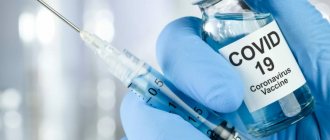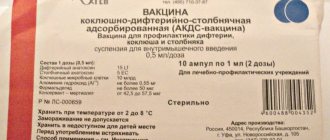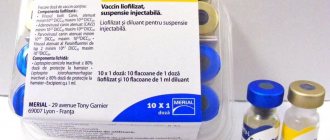Indications for Vianvac vaccination
- population living in areas with a high incidence of typhoid fever;
- population living in areas with chronic water epidemics of typhoid fever;
- persons engaged in the field of municipal improvement (workers servicing sewer networks, structures and equipment, as well as enterprises for sanitary cleaning of populated areas - collection, transportation and disposal of household waste);
- persons working with live cultures of typhoid pathogens;
- persons traveling to hyperendemic regions and countries for typhoid fever, as well as contacts in outbreaks for epidemiological indications.
According to epidemic indications, vaccinations are carried out when there is a threat of an epidemic or outbreak (natural disasters, major accidents in the water supply and sewerage networks), contacts in outbreaks according to epidemic indications, as well as during an epidemic.
Vaccination
The first complex killed vaccine against diphtheria, typhoid and paratyphoid was used in France in 1931 to carry out anti-epidemic measures in army and navy units. In 1936, tetanus toxoid was added to the vaccine. In 1937, the Soviet Army began to use killed vaccine against typhoid fever, paratyphoid A and B and tetanus. To prevent intestinal infections, trivaccine (typhoid fever, paratyphoid A and B) and pentavaccine (typhoid fever, paratyphoid A and B, Flexner and Sonne dysentery) were used.
The disadvantage of live and killed complex vaccines was their high reactogenicity, and when live complex vaccines were administered, an interference phenomenon was observed, depending on the mutual influence of the microbial strains used in associations. In this regard, an intensive search began for the creation of chemical (soluble) multicomponent vaccines, devoid of the disadvantages of corpuscular vaccines and called “associated vaccines.”
The associated polyvaccine NIISI was developed by employees of the Research Institute of the Soviet Army under the leadership of N.I. Alexandrov from the antigens of typhoid fever, paratyphoid A and B, Flexner and Sonne dysentery, Vibrio cholera and tetanus toxoid. Complete somatic O-antigens included in the vaccine were obtained from pathogens of intestinal infections by deep cleavage using trypsin. After alcohol precipitation, the antigens were combined with tetanus toxoid. Calcium phosphate was used as an adjuvant.
In 1941, the first laboratory batches of the polyvaccine . The production of NIISI was mastered at the Institute of Vaccines and Serums named after. I.I. Mechnikov. The composition of the vaccine was slightly changed: the cholera component was excluded, and calcium phosphate was replaced with aluminum hydroxide.
The reactogenicity of the polyvaccine was lower compared to the reactogenicity of corpuscular complex vaccines. The vaccine proved its worth under the harsh conditions of the Great Patriotic War; it was effective with a single injection; three-time vaccination was impossible under war conditions.
The vaccine was not without its shortcomings. Extensive epidemiological studies conducted in 1952 showed insufficient activity of the dysentery antigen, which was excluded from the polyvaccine in 1963. Repeated administration of the vaccine was recommended to achieve durable immunity.
For the needs of the army in the 50-60s, a lot of work was done to create associated vaccines from toxoids. Botulinum triana toxoid (A, B and C), penta toxoid (A, B, C, D and E), as well as various variants of polyanatoxins from gangrenous, botulinum and tetanus toxoids were created. The number of antigens in the associated vaccines reached 18. Such vaccines were used to immunize horses in order to obtain polyvalent immune serum.
Antigens in associated vaccines can have more than just an inhibitory effect on each other. Pertussis corpuscular vaccine and typhoid soluble antigen stimulate the activity of toxoids. Such synergy was observed in a sorbed chemical typhoid vaccine with sextaanatoxin. The vaccine contained typhoid antigen, botulinum A, B and E, gangrenous (perfringens and edematiens) and tetanus toxoids. The vaccine had a high degree of reactogenicity and sufficient immunological effectiveness with the exception of the perfringens component.
In the early 40s, the development of drugs consisting of various combinations of diphtheria, tetanus toxoids and pertussis microbes began simultaneously in many countries. In the Soviet Union, the DTP vaccine began to be used in 1960. Documentation for the drug was created by M.S. Zakharova. In 1963-1965 The DTP vaccine has replaced the non-adsorbed pertussis-diphtheria and pertussis-diphtheria-tetanus vaccines . The DTP vaccine was equal in effectiveness to these drugs, but lower in reactogenicity, since it contained 2 times less microbes and toxoids. Unfortunately, the DTP vaccine still remains the most reactogenic drug among all commercial associated vaccines.
Most developed countries use a live complex virus vaccine (MMR) as part of their vaccination schedule to prevent measles, mumps and rubella. The divaccine has undergone clinical trials in Russia and is widely used in practice for the prevention of measles and mumps.
The arsenal of complex vaccines used in world practice includes: DTP vaccine , influenza vaccine from three circulating strains of the influenza virus, trivalent polio vaccine (live, inactivated) vaccine, pneumococcal vaccine, including 23 serotypes of pneumococcus, meningococcal vaccine from 4 antigens x serotypes of meningococcus, complex vaccines from opportunistic microorganisms, live complex vaccine for the prevention of measles, mumps and rubella. This trivaccine is also available in combination with live vaccines against chickenpox or polio.
The immune response to any vaccine is not uniform. Even the recombinant, highly homogeneous HBsAg of the hepatitis B vaccine contains several determinants, each of which causes the formation of antibodies of a certain specificity. Such determinants are peptides containing 8-12 amino acid residues. Thus, the response to a monovaccine is the sum of responses to the peptide fragments of that vaccine. When associated vaccines are administered, a complex process of formation of antibodies to many antigenic determinants occurs. In addition, some antigens induce cellular immunity rather than antibody production. It is not yet possible to divide this process into individual reactions caused by tens and even hundreds of determinants.
When assessing post-vaccination immunity, diagnostic test systems are usually used that determine the amount of various antibodies specific to individual determinants. Only some diagnostics, for example, test systems for determining antibodies to the human immunodeficiency virus, use synthetic antigens that have a fairly narrow specificity. In addition, antibodies to some antigens, such as typhoid, are not true witnesses of emerging anti-infective resistance. Many of these antigens induce cellular immunity, the assessment of which is difficult due to the lack of reliable and simple diagnostic systems.
Requirements for complex vaccines regarding their safety and immunogenicity include requirements for mono-vaccines. Adverse reactions to associated vaccines, as a rule, occur somewhat more often than to monovaccines, although there is no direct correlation between the degree of reactogenicity of a complex vaccine and the number of its components. The associated vaccine, compared to monovaccines, causes only a slight increase in the number of individuals who react with the formation of autoantibodies to the introduction of vaccines. When developing combination vaccines, the compatibility of not only the antigenic components, but also their various additives (adjuvants, preservatives, stabilizers, etc.) is taken into account.
Contraindications
Only a doctor can decide whether VIANVAC is suitable for vaccination
VIANVAC is contraindicated if there is a history of an allergic reaction to any component of the vaccine.
Vianvac vaccination is contraindicated in the following cases:
- Hypersensitivity to any component of the vaccine, including neomycin; symptoms of hypersensitivity to previous vaccine administration.
- Acute infectious and non-infectious diseases, exacerbation of chronic diseases are temporary contraindications for vaccinations; for mild ARVI and acute intestinal diseases, vaccination is carried out immediately after the temperature has normalized.
- Pregnancy or planned pregnancy within 1 month after vaccination. Breastfeeding period.
Chemical sorbed typhoid vaccine (T)
Chemical sorbed typhoid vaccine (T) - Vaccinum typhosum chemicum adsorptum (T).
Characteristics of the drug
Chemical sorbed typhoid monovaccine (T) is a colorless liquid with an amorphous precipitate of aluminum hydroxide suspended in it (with the complete typhoid bacillus antigen adsorbed on it), which settles to the bottom when standing and easily breaks when shaken.
Purpose, indications and contraindications
Chemical sorbed typhoid vaccine is intended for the prevention of typhoid fever by creating active artificial immunity. Vaccination is carried out for children aged 7-14 years and adults aged 15 to 55 years.
Contraindications for vaccinations:
- history of diseases of the central nervous system - infectious (encephalitis, meningitis, poliomyelitis, etc.), as well as those associated with injuries;
- acute and chronic nephritis;
- active forms of tuberculosis and tuberculosis intoxication;
- allergic conditions, acute and chronic rheumatism, asthma, eczema, food and other idiosyncrasies in the anamnesis and confirmed by a doctor;
- heart disease - congenital and acquired defects, myocarditis;
- diseases of the blood system, including malignant and severe anemia;
- peptic ulcer of the stomach and duodenum;
- diseases of the liver and biliary tract (acute and chronic);
- metabolic and endocrine system diseases (diabetes mellitus and others);
- malignant neoplasms;
- lupus erythematosus and other collagenoses;
- spasmophilia;
- congenital malformations of the central and peripheral nervous system;
- all diseases accompanied by cachexia;
- acute infectious diseases, including influenza, until full recovery of health, after suffering from epidemic hepatitis, vaccinations are contraindicated for 6 months;
- furunculosis;
- acute intestinal disorders;
- feverish condition;
- previous typhoid fever;
- If there is a quarantine in a children's institution, school, apartment, or dormitory for any infection, vaccinations for children who have not survived this infection are not carried out during quarantine.
Methods of application, doses
The vaccine is administered strictly subcutaneously to children from 7 to 14 years old at a dose of 0.6 ml, to persons from 15 to 55 years old at a dose of 1.0 ml (once). Revaccination in a dose of 1.0 ml is carried out (once) if necessary, no earlier than after 6 months.
“Care, nutrition and vaccine prevention of a child”, F.M. Kitikar
Preventive vaccination calendar
According to the degree of necessity, all vaccinations are divided into planned (mandatory) and according to epidemiological indications. Routine vaccinations are carried out for the purpose of immunoprophylaxis of the most common or dangerous infectious diseases, mainly anthroponoses with airborne transmission of pathogens, according to epidemiological indications - only in those places where it is necessary to ensure the immune layer of the population at risk of the disease, and when other measures...
Objectives and organization of vaccine prevention of infectious diseases
Specific prevention of infectious diseases plays a significant role in the system of anti-epidemic measures. It is thanks to the widespread use of immunoprophylaxis that great successes have been achieved in the fight against many infectious diseases (diphtheria, polio, whooping cough, measles, tetanus, etc.). In our country alone, about 170 million vaccinations are performed per year. As a result, the incidence of many infections has sharply decreased, even to the point of elimination...
Persons subject to vaccination
Persons to be vaccinated must first be examined by a doctor (paramedic at a paramedic-obstetric or paramedic station) taking into account anamnestic data. Persons with contraindications listed in the instructions attached to the vaccine are not allowed to receive vaccinations, permanently or temporarily. Children with chronic diseases, allergic conditions and others living in rural areas are vaccinated only after consulting a doctor. On the day of vaccination, the person being vaccinated also...
Vaccination office
In the room where vaccinations will be carried out, you must first thoroughly wash the floors and furniture, preferably using disinfectant solutions. Tables for tools and couches for children are covered with ironed sheets. Children should not be vaccinated in rooms where sick people are received. Personnel must work in clean gowns and caps (scarves). Health workers suffering from pustular skin diseases, sore throats,…
Tularemia live dry skin vaccine
Tularemia live dry cutaneous vaccine - Vaccinum tularaemicum vivum siccum. Characteristics of the drug Tularemia dry vaccine is a vacuum-dried suspension (in a sucrose-gelatin solution) of a culture of the tularemia vaccine strain grown on an artificial nutrient medium. First developed by Soviet scientists N.A. Taisky and B.Ya. Elbert in 1942. Purpose, indications and contraindications Live cutaneous tularemia…



